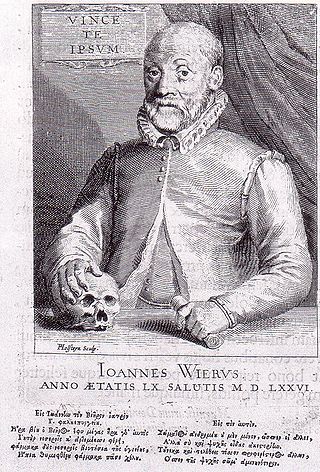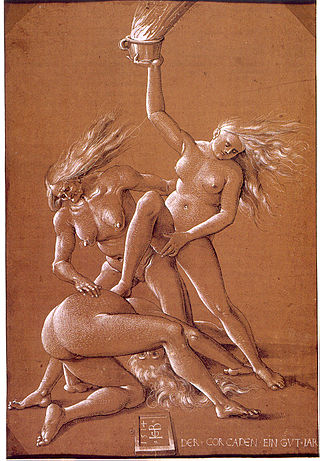
The Malleus Maleficarum, usually translated as the Hammer of Witches, is the best known treatise about witchcraft. It was written by the German Catholic clergyman Heinrich Kramer and first published in the German city of Speyer in 1486. Some describe it as the compendium of literature in demonology of the 15th century. Kramer presented his own views as the Roman Catholic Church's position.
Christian views on magic vary widely among Christian denominations and among individuals. Many Christians actively condemn magic as satanic, holding that it opens the way for demonic possession. Some Christians simply view it as entertainment. Conversely, some branches of esoteric Christianity actively engage in magical practices.

Heinrich Kramer, also known under the Latinized name Henricus Institor, was a German churchman and inquisitor. With his widely distributed book Malleus Maleficarum (1487), which describes witchcraft and endorses detailed processes for the extermination of witches, he was instrumental in establishing the period of witch trials in the early modern period. Professor Malcolm Gaskill has described Kramer as a "superstitious psychopath."

A Hand of Glory is the dried and pickled hand of a hanged man, often specified as being the left hand, or, if the person was hanged for murder, the hand that "did the deed."
Black magic traditionally refers to the use of magic or supernatural powers for evil and selfish purposes.

A Witches' Sabbath is a purported gathering of those believed to practice witchcraft and other rituals. The phrase became especially popular in the 20th century.

A Black Mass is a ceremony celebrated by various Satanic groups. It has allegedly existed for centuries in different forms, and the modern form is intentionally a sacrilegious and blasphemous parody of a Catholic Mass.
Peter Binsfeld was a German auxiliary bishop and theologian.

Francesco Maria Guazzo, aka Guaccio, aka Guaccius (1570–16??) was an Italian priest. He is most well known for authoring the Compendium Maleficarum.

There have been various attempts at the classification of demons within the contexts of classical mythology, demonology, occultism, and Renaissance magic. These classifications may be for purposes of traditional medicine, exorcisms, ceremonial magic, witch-hunts, lessons in morality, folklore, religious ritual, or combinations thereof. Classifications might be according to astrological connections, elemental forms, noble titles, or parallels to the angelic hierarchy; or by association with particular sins, diseases, and other calamities; or by what angel or saint opposes them.

Summis desiderantes affectibus, sometimes abbreviated to Summis desiderantes, was a papal bull regarding witchcraft issued by Pope Innocent VIII on 5 December 1484.

Daemonologie—in full Dæmonologie, In Forme of a Dialogue, Divided into three Books: By the High and Mightie Prince, James &c.—was first published in 1597 by King James VI of Scotland as a philosophical dissertation on contemporary necromancy and the historical relationships between the various methods of divination used from ancient black magic. It was reprinted again in 1603 when James took the throne of England. The widespread consensus is that King James wrote Daemonologie in response to sceptical publications such as Reginald Scot's The Discoverie of Witchcraft.

Augustus Montague Summers was an English author, clergyman, and teacher. As an independent scholar, he published many works on the English drama of the Stuart Restoration (1660–1688) and helped to organise and to promote the performance of plays from that period. He also wrote extensively on the occult and has been characterized as "arguably the most seminal twentieth century purveyor of pop culture occultism."

The Directorium Inquisitorum is Nicholas Eymerich's most prominent and enduring work, written in Latin and consisting of approximately 800 pages, which he had composed as early as 1376. Eymerich had written an earlier treatise on sorcery, perhaps as early as 1359, which he extensively reworked into the Directorium Inqusitorum. In compiling the book, Eymerich used many of the magic texts he had previously confiscated from accused sorcerers. It can also be considered as an assessment of a century and a half of official Inquisition in the "albigensian" country.

De praestigiis daemonum, translated as On the Tricks of Demons, is a book by medical doctor Johann Weyer, also known as Wier, first published in Basel in 1563. The book argues that witchcraft does not exist and that those who claim to practice it are suffering from delusions, which should be treated as mental illnesses, rather than punished as witchcraft. It was influential in the abolishment of witchcraft trials in the Netherlands.
The Formicarius, written 1436–1438 by Johannes Nider during the Council of Florence and first printed in 1475, is the second book ever printed to discuss witchcraft. Nider dealt specifically with witchcraft in the fifth section of the book. Unlike his successors, he did not emphasize the idea of the Witches' Sabbath and was skeptical of the claim that witches could fly by night. With over 25 manuscript copies from fifteenth and early sixteenth century editions from the 1470s to 1692, the Formicarius is an important work for the study of the origins of the witch trials in Early Modern Europe, as it sheds light on their earliest phase during the first half of the 15th century.

European belief in witchcraft can be traced back to classical antiquity, when magic and religion were closely entwined. During the pagan era of ancient Rome, there were laws against harmful magic. After Christianization, the medieval Catholic Church began to see witchcraft (maleficium) as a blend of black magic and apostasy involving a pact with the Devil. During the early modern period, witch hunts became widespread in Europe, partly fueled by religious tensions, societal anxieties, and economic upheaval. European belief in witchcraft gradually dwindled during and after the Age of Enlightenment.

Witch, from the Old English wiċċe, is a term rooted in European folklore and superstition for a practitioner of witchcraft, magic or sorcery. Traditionally associated with malevolent magic, with those accused of witchcraft being the target of witch-hunts, in the modern era the term has taken on different meanings. In literature, a 'witch' can now simply refer to an alluring women capable of 'bewitching' others. In neopagan religions such as Wicca the term has meanwhile been adopted as the female term for an adherent.

The Discoverie of Witchcraft is a book published by the English gentleman Reginald Scot in 1584, intended as an exposé of early modern witchcraft. It contains a small section intended to show how the public was fooled by charlatans, which is considered the first published material on illusionary or stage magic.














